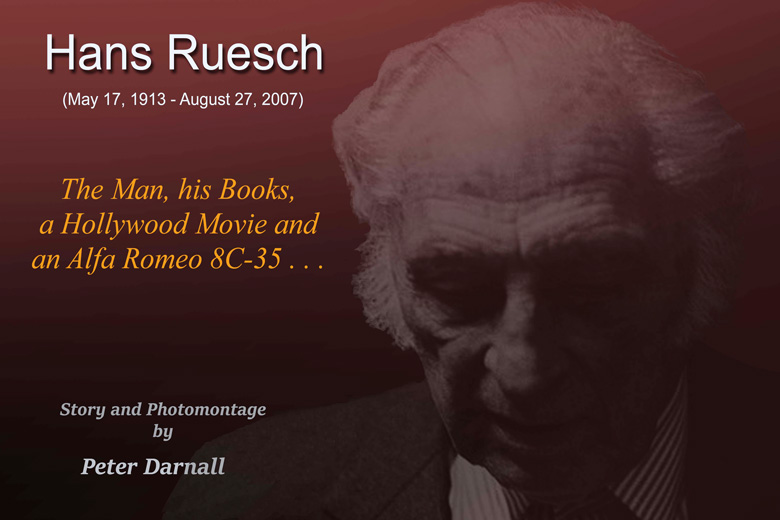
Montage image from photographer Piergiorgio Bardi aka Häaden 2 Como, Italy
Story and Montage by Peter Darnall
Additional photos from the collection of Dale LaFollette
Alfa Romeo Tipo C #50013 . . . The Hans Ruesch Era
The 1936 racing season brought victories for the Tipo C Alfa Romeos against the German Silver Arrows at Penya Rhin, Milan, and Budapest. The new monoposto showed it could compete with the Teutonic rivals—at least on tight winding courses when pushed to the absolute limit by Tazio Nuvolari. Italian hopes were high as the cars lined up for the start of the Coppa Ciano on August 2, 1936. No one could have known at that time, but Nuvolari was about to put on a virtuoso performance which would rank as one of the greatest drives of all time.
For safety reasons, the mountain section of the Montenero circuit at Livorno had been eliminated and the course shortened from 20 km to 7.218 km. Daimler Benz opted to miss the event, but Auto Union brought three cars for Bernd Rosemeyer, Achille Varzi, and Hans Stuck. Scuderia Ferrari entered four Tipo C Alfas: two V-12s for Tazio Nuvolari and Antonio Brivio and two 8-cylinder machines for René Dreyfus and Carlo Pintacuda.
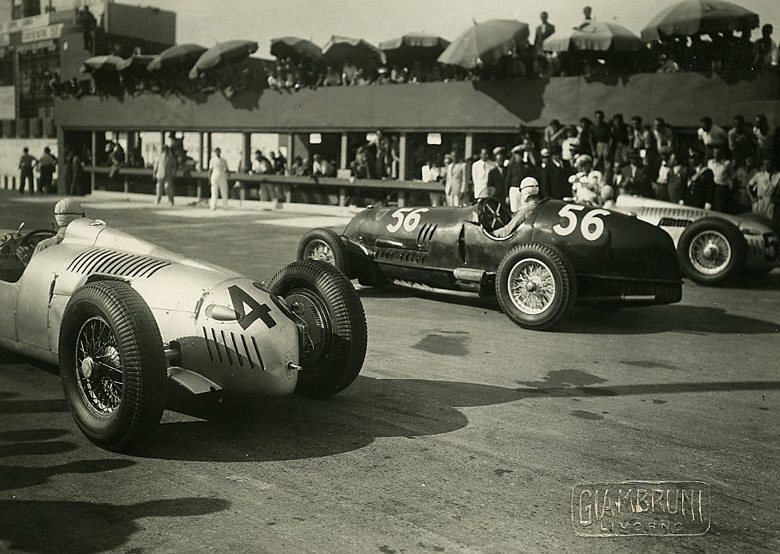
1936 Coppa Ciano, Achille Varzi, #48 Auto Union, Tazio Nuvolari, #56 Alfa Romeo 12C, Bernd Rosemeyer, #54 Auto Union. From the collection of Dale LaFollette
At the drop of the starter’s flag, Varzi took the lead followed by Rosemeyer, Brivio, Stuck, Dreyfus, and Pintacuda. Nuvolari’s Alfa was sidelined moments after the start by a broken drive train, forcing the Italian ace to return to the pits on foot. Acceding to Nuvolari’s demand for an 8-cylinder car, Pintacuda’s Alfa was called in and turned over to Nuvolari, who rejoined the race now down multiple laps and struggling with a car not set up for his small stature.
With wildly cheering spectators lining the narrow streets, Nuvolari overcame the huge deficit and drove through the entire field to take an unbelievable win. Brivio came home in second and Dreyfus followed in third place giving Scuderia Ferrari a clean sweep of the first three places and a clear win over the Auto Union rivals.
* * * * *
Hans Ruesch was a true Renaissance man. He had academic backgrounds in both law and medicine. He was a gifted writer and also drove race cars at the highest level; between the years 1932-1937, he scored twenty-seven wins, three second places and five third places. As a privateer, he raced all around Europe, South Africa, and the Scandinavian countries. As an author, he had several successful books and two major Hollywood motion pictures to his credit. In his later years, he became an internationally prominent activist against animal experimentation and vivisection.
Hans Ruesch died at his home in Massagno, Switzerland, on August 27, 2007 at the age of 94. At the time of his death, he was believed to be one of the last surviving drivers from the Golden Era of Grand Prix which ended with the outbreak of the Second World War. Ruesch was born in Naples, Italy to Swiss parents and was a Swiss citizen. He attended boarding school in Switzerland and studied Law at the University of Zurich, but left school in 1932 to pursue his interest in racing cars.
His first competition was the Klausenrennen with an MG. Over the years he became a successful privateer driving a number of potent race cars including the ex-Guy Moll Maserati 8CM (#3022), an Alfa Romeo Tipo B Monoposto (#5002), and a pair of 8C-2300 Alfas (#211084, #211136). By the mid-1930s, Ruesch was driving at the highest level, competing with the legendary drivers of the era on venues across Europe.
In September of 1936, Ruesch purchased an 8C-35 Alfa Romeo from Scuderia Ferrari. The car carried Engine/Chassis Number 50013 and was documented as Scuderia Ferrari Number 65. This Tipo C may have been the car Tazio Nuvolari drove to victory in the 1936 Coppa Ciano, but the documentation is not conclusive. Ruesch’s purchase is important for another reason: The Tipo C Alfas were subsequently cannibalized by the Scuderia to produce an upgraded racer, the Alfa Romeo 308 or 308-C. Hans Ruesch’s car escaped this fate and is the only Tipo C surviving today with both original engine and chassis serial numbers intact.
Ruesch shipped the Alfa to England for the September Shelsley Walsh hill-climb event where he took 2nd fastest time of the day. Recrossing the Channel, Ruesch scored his first win with the Alfa at Course de Côte de Lapize in France on September 27th. Teaming with British star driver, R. J. B. “Dick” Seaman, Ruesch entered the second running of the Donington Grand Prix at Donington Park on October 3rd. Although Seaman was about four seconds faster than Ruesch over 2.5 mile circuit, Ruesch started the event and handed the car over to Seaman at mid-distance with a comfortable lead. Seaman cruised through the remaining laps to take an easy win. On October 3rd, Ruesch took on the Mountain Circuit Championship at Brooklands where he finished second to established star Raymond Mays in a works-entered ERA. In slightly over a month, the Alfa had showed its potential and the British racing public took note; Ruesch’s Alfa would continue to race taking on all comers on venues across Europe and South Africa and was to become a British icon under new ownership following the Second World War.
Hans Ruesch immigrated to the United States barely escaping the outbreak of war in Europe. While in the United States, he wrote short fiction for Esquire, The Saturday Evening Post, Collier’s, and Redbook magazines. He returned to Naples in 1946 to pursue his writing interests. His most popular novels include Top of the World, Harper, 1950), The Racer (Ballantine, 1953), and South of the Heart: A Novel of Modern Arabia (Coward-McCann 1959). Two of his novels, Top of the World and The Racer became Hollywood films.
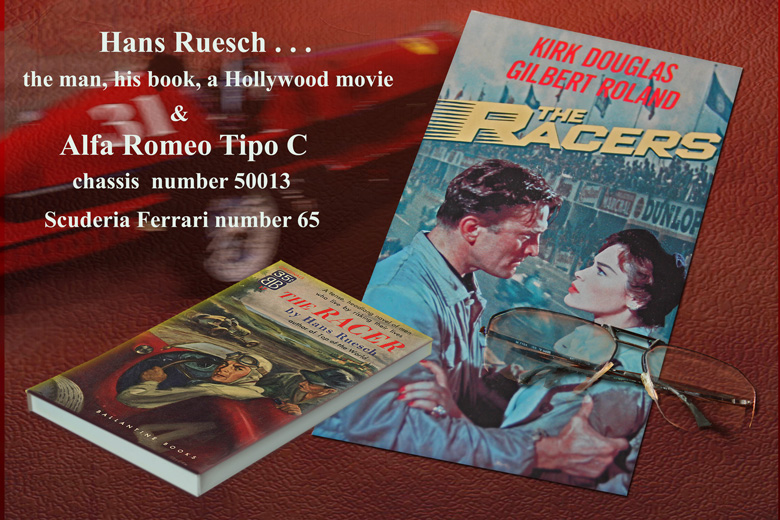
Montage by Peter Darnall. Read more abut the movie.
The Racer, which was a rewrite of his 1937 book, Il Numero Uno, was essentially a compendium of Ruesch’s own racing experiences. The Racer, which I purchased in 1953, became my window into the European racing scene of the 1930s. The action starts on page one with a breath-taking run on a rain-soaked Via Emilia in an open sports racing car contesting the Mille Miglia. The main character, Erich Lester, is a struggling young driver who ruthlessly pushes his cars to the absolute limit in his quest to secure a spot on the dominant German racing team. Ruesch’s descriptions of the cars and the circuits are superb; he was a gifted story-teller as well as an accomplished racing driver.
The Racer was made into a full-length motion picture by Twentieth Century-Fox Studio in 1955. The film was produced by Henry Hathaway and starred Kirk Douglas, Gilbert Roland, and Bella Darvi. One critic at the time observed “Interesting glimpses of the European racing scene of the early 1950s, but the cars were cosmetically altered and the racing scenes appeared contrived.” All true, but the critic was not a sports car enthusiast. I remember the film well; we cheered the opening credit acknowledging Phil Hill’s technical assistance and were mesmerized by the CinemaScope coverage of the famous European circuits.
In his later life, Ruesch became one of the leading figures in the anti-vivisection movement. While living in Rome, he announced that he would never again write fiction while the practice of vivisection continued. Hans Ruesch was a truly remarkable man who achieved greatness in whatever endeavors he chose to pursue. His Tipo C Alfa Romeo would pass on to new owners and subsequently sold at the Bonhams Goodwood Revival Auction on September 14, 2013.
Both Hans Ruesch’s book, The Racer, and the video of the movie, The Racers, are on my bookshelf today. Sadly, neither the details of the ownership nor the whereabouts of Alfa Romeo #50013 are known at this time.
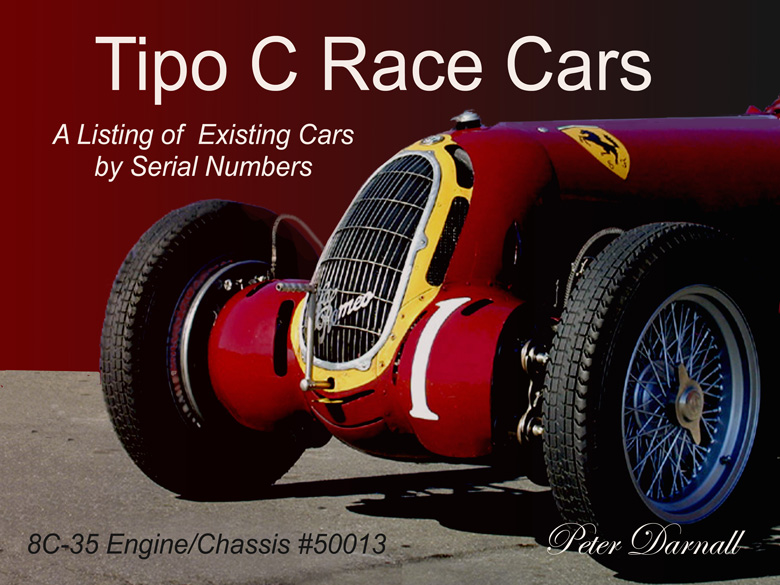
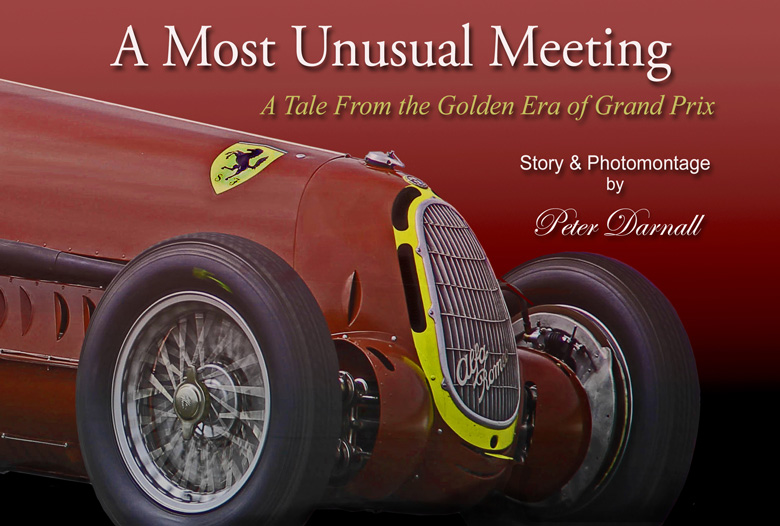
His life was truely a remarkable one. Sadly his post war racing came to bad
end when he raced a Ferrari 340 MM in 1953. Started off on a funny note
in June at the Isle of Man honking at Moss when trying to pass. In the heat
of Senigallia in August, he rolled the car, but managed to finish. Must have been
an omen since his final race came month later in Merano and seriously injured.
Years later Phil Hill would comment on that type Ferrari as a tricky car, using
several examples of drivers he seen come to grief in France and England. He
told me of his scary experience at Rheims during the night race. Making his
European Ferrari debut in Bill Spears car, was as he told me, ” Glad to retire !”
Jim sitz
I have a very interesting book by Hans Reusch called the Great Thirst that was made into a film called Black Gold.
I saw that movie on Channel 9, NYC in the 60’s, first race movie I saw, except for the Mickey Rooney dirt track one. You Tube has part of it, check out the wrecked and burning Ferrari. {?} Pretty Cheesy but its there.
the foto on the title picture
is mine
Piergiorgio Bardi aka Häaden 2
Como, Italy
i’m a professional photographer
and hans was a good friend of mine
so i sent the photo to wikipedia just for that use, after his death in 2007
the photo was taken in Tradate (Varese, italy) in 1993 during a conference where we invited him
please, quote the author
thanks
p
Thank you very much for informing us; it is s truly great photo. We have credited you underneath the montage.
Sincerely,
Pete Vack
Editor, VeloceToday
thank you